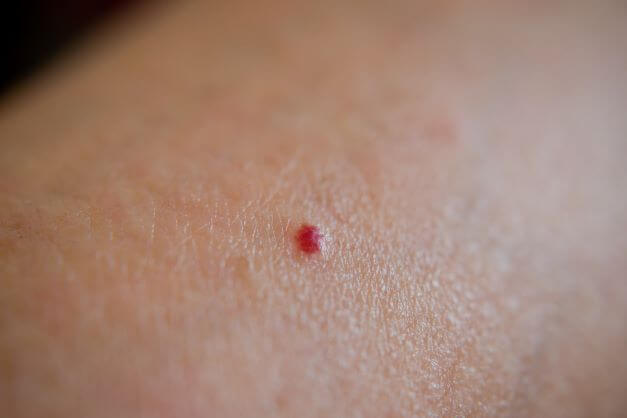Cherry angiomas are fairly common, benign skin growths. If you have one or more, you may be curious about what treatment options are available. According to Dr. Lauren Snitzer of U.S. Dermatology Partners in Sugar Land, Texas, “The good news is you don’t have to have cherry angiomas removed. In almost all cases, these growths are completely harmless. If you don’t like the appearance of cherry angiomas or they’re in a location where they’re regularly irritated or bumped, cherry angiomas are also easily removed. There are several minimally invasive treatment options that can be performed in just one visit with a board-certified dermatologist.” In this blog, you can learn more about what cherry angiomas are and how to remove these benign skin lesions.
What Is a Cherry Angioma?
A cherry angioma is a common skin irregularity that causes small, red growths to develop on the skin. The red coloring is caused by numerous, dilated capillaries beneath the skin. The name cherry angioma is derived from the typical cherry-red coloring of these benign skin growths. However, they can actually range in color from red to blue or purple. In addition to being referred to as cherry angiomas, these irregularities are also sometimes referred to as Campbell de Morgan spots and senile angiomas. This last name refers to the fact that cherry angiomas typically develop in people over the age of 30, and they are much more common in older adults.
Cherry angiomas are usually smooth in texture. They can be flat or slightly raised from the skin. Cherry angiomas can be very small, the size of a pinhead, but these growths can also grow as large as a quarter-inch in diameter. Developing larger growths is much more common in older patients. Cherry angiomas can develop on any area of the body, but they are most common on the shoulders, torso, arms, and legs. While a cherry angioma is usually easy to identify due to its unique color and appearance, it’s best to have the diagnosis verified by a dermatologist since some more serious skin conditions may look like cherry angiomas.
What Causes Cherry Angiomas?
According to Dr. Snitzer, “There’s no specific underlying cause for cherry angiomas. However, many factors seem to signify an increase in the risk for developing them. Age is the most common risk factor. Most people develop these growths after the age of 30, and the risk for developing cherry angiomas increases with age. Genetic predisposition is the second most common risk factor for cherry angiomas. If you have one or more family members who have cherry angiomas, you are significantly more likely to develop them.”
In addition to age and genetics, the following factors may increase the risk for developing cherry angiomas:
- Hormonal changes, including pregnancy
- Certain medical conditions
- Exposure to some chemicals
- Living in specific climates, especially hot, humid locations
What Cherry Angioma Treatment & Removal Options Are Available?
For the most part, cherry angiomas are benign, so you don’t necessarily need to seek out treatment for these skin growths. However, you may want to have a cherry angioma removed in the following situations:
- The appearance of the cherry angioma is a concern
- The cherry angioma develops in a very noticeable place
- The location of the mole causes discomfort or irritation
- The mole bleeds easily and doesn’t heal quickly, which can be an infection risk
- There are any changes in the size, shape, or color of the cherry angioma that could be a warning sign for skin health concerns, including skin cancers
If you and your dermatologist decide to move forward with removing cherry angiomas for these or any other reasons, there are several conservative treatment options available to remove cherry angiomas quickly and comfortably, including:
Electrocauterization
Electrocauterization is a cherry angioma removal method that uses electricity to create heat that is used to destroy the irregular tissue and cauterize the area to stop bleeding quickly. The process is great to prevent excessive bleeding and promote faster healing after treatment. Since the electrocauterization process itself can be a bit uncomfortable, a local anesthetic is typically used to ensure total comfort throughout the treatment process.
Cryotherapy
Cryotherapy procedures use liquid nitrogen to destroy the cherry angioma by freezing. In most cases, a small dab of liquid nitrogen will be placed on the cherry angioma, causing it to freeze. Then, it will slowly thaw out. As the cherry angioma warms back up, the cells will be destroyed. If the mole is very large, it may require more than one cryotherapy application to completely remove. Following cryotherapy treatment, the affected area may blister or scab. It’s important to follow all aftercare instructions from your dermatologist to ensure fast healing and avoid any adverse side effects.
Laser Therapy
Laser therapy uses highly concentrated light energy to destroy the cherry angioma skin cells. The laser light wavelength is calibrated to remove tissues of specific coloring, allowing for advanced precision to ensure the most conservative treatment that avoids damaging healthy skin tissue. Laser therapy is also more comfortable and ensures less swelling, irritation, inflammation, and scarring after treatment compared with other treatment options.
Surgical Removal
Surgical removal of cherry angiomas may involve the Mohs Surgical Technique. This minimally invasive surgical excision process works by removing the cherry angioma and the outermost layer of skin around the growth. This conservative surgery approach ensures the procedure itself is more comfortable, minimizes the number of stitches necessary following the procedure, and reduces healing time. During this procedure, your dermatologist can also examine the excised tissue for cancerous cells.
How to Get Started Working with U.S. Dermatology Partners
If you’re interested in learning more about cherry angiomas or you want to get started with treatment, the U.S. Dermatology Partners team would be happy to hear from you. Simply take a few minutes to complete our online scheduling request form. Once our local dermatology practice receives your request form, we’ll be in touch to answer any questions you have and finalize the details of your visit.
Find a location near me
or


